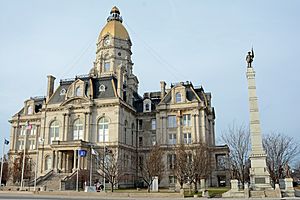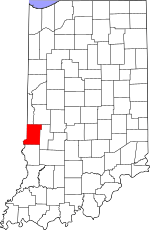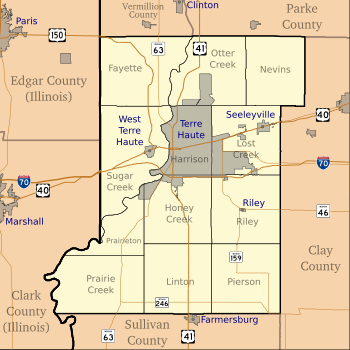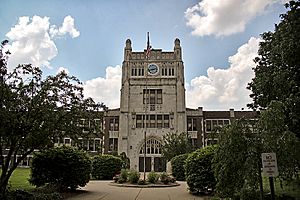Vigo County, Indiana facts for kids
Quick facts for kids
Vigo County
|
|
|---|---|
| County of Vigo | |

Vigo County Courthouse in Terre Haute
|
|

Location within the U.S. state of Indiana
|
|
 Indiana's location within the U.S. |
|
| Country | |
| State | |
| Founded | February 1, 1818 |
| Named for | Francis Vigo |
| Seat | Terre Haute |
| Largest city | Terre Haute |
| Area | |
| • Total | 410.45 sq mi (1,063.1 km2) |
| • Land | 403.31 sq mi (1,044.6 km2) |
| • Water | 7.14 sq mi (18.5 km2) 1.74%% |
| Population | |
| • Estimate
(2019)
|
107,038 |
| • Density | 265.4/sq mi (102.5/km2) |
| Time zone | UTC−5 (Eastern) |
| • Summer (DST) | UTC−4 (EDT) |
| Congressional district | 8th |
| Indiana county number 84 | |
Vigo County ( VEE-goh or VY-goh) is a county on the western border of the U.S. state of Indiana. According to the 2010 United States Census, the population was 107,848. The county seat is Terre Haute.
Vigo County is included in the Terre Haute metropolitan area.
The county contains four incorporated settlements with a total population of nearly 63,000, as well as several unincorporated communities. It is divided into twelve townships which provide local services to the residents.
The county is one of the best bellwether regions for voting in U.S. presidential elections; it voted for the winning candidate in every election from 1956 to 2016 and in all but three elections since 1888. Until the streak ended in 2020, only one county in the United States, Valencia County, New Mexico, had voted for the winning candidate longer.
Contents
History
Sullivan County was formed in 1817, and the area that later became Vigo County was part of it until 1818, when the county was created by an act of the Indiana General Assembly which took effect on February 1. Its borders changed several times; in 1821, part of the county was formed into Parke County, and later that year Putnam County was formed which also affected Vigo's borders. The final change came in 1873 when the present boundaries were defined. The county is named in honor of Colonel Francis Vigo, of Italian heritage but a citizen of Spain due to residence in St. Louis. He is credited with great assistance to George Rogers Clark both in financing Clark's exploration and American Revolutionary War efforts, and in service as an agent obtaining military information for Clark against British campaigns on the then frontier.
Geography
To the north of Vigo County, the Wabash River defines the boundary between Vermillion and Parke counties; the river then enters Vigo County and winds to the south-southwest, defining the southern portion of the county's western border before continuing south along Sullivan County's western border. Vigo County is thus the southernmost county in Indiana on the right bank of the Wabash. Clay County lies to the east. Across the state line are Edgar County to the northwest and Clark County to the southwest. According to the 2010 census, the county has a total area of 410.45 square miles (1,063.1 km2), of which 403.31 square miles (1,044.6 km2) (or 98.26%) is land and 7.14 square miles (18.5 km2) (or 1.74%) is water.
In 1819, the year after the county was formed, it was divided into four townships: Honey Creek, Wabash, Harrison and Independence. Prairie Creek Township was formed later that year. In the following years more townships were formed and township borders were altered several times. Otter Creek, Raccoon and Sugar Creek townships were created in 1820, and Independence Township became known as Paris Township. Raccoon and Wabash townships became part of Parke County when it was split from Vigo County in 1821. Nevins and Riley were formed in 1822. In 1824, Paris Township was renamed again to Fayette Township. Pierson Township was created in 1829, then Lost Creek in 1831, then Linton in 1841 and finally Prairieton in 1857, for a total of twelve townships.
There are four incorporated settlements within Vigo County. The largest, Terre Haute, has a population of almost 60,000 and covers all of Harrison Township and extends into several surrounding townships. West Terre Haute, as its name indicates, lies to the west, along U.S. Route 40; it has a population of about 2,300. The town of Seelyville lies to the east of Terre Haute, also along U.S. Route 40, with a population of about 1,200. The smallest town, Riley, is southeast of Terre Haute and has a population of only 160.
Unincorporated towns
Census-designated places
- Dresser (or Taylorville)
- Fontanet
- New Goshen
- North Terre Haute
- St. Mary-of-the-Woods
- Shepardsville
- Toad Hop
Other places
Transportation
Highways
Interstate 70 passes through the southern part of Terre Haute from east to west on its way from Indianapolis to Saint Louis, Missouri; U.S. Route 40 roughly parallels Interstate 70 and passes through the middle of the city. Both highways intersect U.S. Route 41, coming from Chicago to the north; U.S. Route 150 enters from Paris, Illinois to the northwest and joins U.S Route 41 in downtown Terre Haute, and both continue south toward Vincennes.
 State Road 42
State Road 42 State Road 46
State Road 46 State Road 63
State Road 63 State Road 159
State Road 159 State Road 246
State Road 246 State Road 340
State Road 340- State Road 641*State Road 342
(* SR 641 is currently under construction. Its current route begins at US 41 and ends at McDaniel Road.)
Rail
Several CSX Transportation railroad lines meet in Terre Haute; one enters from the north, another from the Indianapolis area, and another from Vincennes; and two others enter from Illinois. There is also an Indiana Rail Road line which runs southeast from Terre Haute toward Bedford.
Airports
The following public-use airports are located in the county:
- Terre Haute International Airport (HUF) in Terre Haute
- Sky King Airport (3I3) in Terre Haute
Climate and weather
| Weather chart for Terre Haute, Indiana | |||||||||||||||||||||||||||||||||||||||||||||||
|---|---|---|---|---|---|---|---|---|---|---|---|---|---|---|---|---|---|---|---|---|---|---|---|---|---|---|---|---|---|---|---|---|---|---|---|---|---|---|---|---|---|---|---|---|---|---|---|
| J | F | M | A | M | J | J | A | S | O | N | D | ||||||||||||||||||||||||||||||||||||
|
2.1
35
18
|
2.6
41
22
|
3.7
52
33
|
4.1
64
42
|
4.5
75
52
|
4.1
84
61
|
4.5
87
65
|
3.7
85
63
|
3.4
79
55
|
3
68
44
|
3.8
53
34
|
3
41
23
|
||||||||||||||||||||||||||||||||||||
| temperatures in °F precipitation totals in inches source: The Weather Channel |
|||||||||||||||||||||||||||||||||||||||||||||||
|
Metric conversion
|
|||||||||||||||||||||||||||||||||||||||||||||||
In recent years, average temperatures in Terre Haute have ranged from a low of 18 °F (−8 °C) in January to a high of 87 °F (31 °C) in July, although a record low of −24 °F (−31 °C) was recorded in January 1977 and a record high of 104 °F (40 °C) was recorded in September 1954. Average monthly precipitation ranged from 2.13 inches (54 mm) in January to 4.46 inches (113 mm) in May.
Demographics
| Historical population | |||
|---|---|---|---|
| Census | Pop. | %± | |
| 1820 | 3,390 | — | |
| 1830 | 5,766 | 70.1% | |
| 1840 | 12,076 | 109.4% | |
| 1850 | 15,289 | 26.6% | |
| 1860 | 22,517 | 47.3% | |
| 1870 | 33,549 | 49.0% | |
| 1880 | 45,658 | 36.1% | |
| 1890 | 50,195 | 9.9% | |
| 1900 | 62,035 | 23.6% | |
| 1910 | 87,930 | 41.7% | |
| 1920 | 100,212 | 14.0% | |
| 1930 | 98,861 | −1.3% | |
| 1940 | 99,709 | 0.9% | |
| 1950 | 105,160 | 5.5% | |
| 1960 | 108,458 | 3.1% | |
| 1970 | 114,528 | 5.6% | |
| 1980 | 112,385 | −1.9% | |
| 1990 | 106,107 | −5.6% | |
| 2000 | 105,848 | −0.2% | |
| 2010 | 107,848 | 1.9% | |
| 2015 (est.) | 107,896 | 0.0% | |
| U.S. Decennial Census 2012 Estimate |
|||
As of the 2010 United States Census, there were 107,848 people, 41,361 households, and 25,607 families residing in the county. The population density was 267.4 inhabitants per square mile (103.2/km2). There were 46,006 housing units at an average density of 114.1 per square mile (44.1/km2). The racial makeup of the county was 88.3% white, 6.9% black or African American, 1.7% Asian, 0.3% American Indian, 0.6% from other races, and 2.2% from two or more races. Those of Hispanic or Latino origin made up 2.3% of the population. In terms of ancestry, 22.6% were German, 20.2% were American, 12.2% were Irish, and 10.3% were English.
Of the 41,361 households, 30.2% had children under the age of 18 living with them, 43.9% were married couples living together, 13.1% had a female householder with no husband present, 38.1% were non-families, and 30.6% of all households were made up of individuals. The average household size was 2.38 and the average family size was 2.95. The median age was 36.1 years.
The median income for a household in the county was $47,697 and the median income for a family was $50,413. Males had a median income of $42,014 versus $30,217 for females. The per capita income for the county was $20,398. About 13.3% of families and 19.5% of the population were below the poverty line, including 27.5% of those under age 18 and 9.5% of those age 65 or over.
Education
The public schools in the county are part of the Vigo County School Corporation. During the 2009–10 school year, the schools served a total of 16,014 students.
Vigo County is served by the Vigo County Public Library.
Colleges in Vigo County include Indiana State University and Rose-Hulman Institute of Technology. For a fuller list, see the List of schools in metropolitan Terre Haute.
See also
 In Spanish: Condado de Vigo para niños
In Spanish: Condado de Vigo para niños



